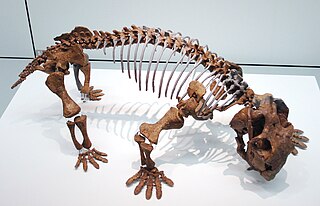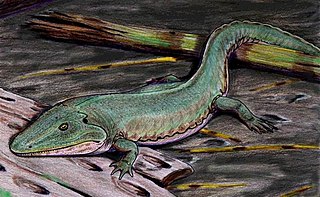
The Permian is a geologic period and stratigraphic system which spans 47 million years from the end of the Carboniferous Period 298.9 million years ago (Mya), to the beginning of the Triassic Period 251.902 Mya. It is the last period of the Paleozoic Era; the following Triassic Period belongs to the Mesozoic Era. The concept of the Permian was introduced in 1841 by geologist Sir Roderick Murchison, who named it after the region of Perm in Russia.
The PaleozoicEra is the first of three geological eras of the Phanerozoic Eon. Beginning 538.8 million years ago (Ma), it succeeds the Neoproterozoic and ends 251.9 Ma at the start of the Mesozoic Era. The Paleozoic is subdivided into six geologic periods :

Approximately 251.9 million years ago, the Permian–Triassicextinction event forms the boundary between the Permian and Triassic geologic periods, and with them the Paleozoic and Mesozoic eras respectively. It is the Earth's most severe known extinction event, with the extinction of 57% of biological families, 83% of genera, 81% of marine species and 70% of terrestrial vertebrate species. It is also the largest known mass extinction of insects. It is the largest of the "Big Five" mass extinctions of the Phanerozoic. There is evidence for one to three distinct pulses, or phases, of extinction.

A therapsid is a member of the clade Therapsida which is a major group of eupelycosaurian synapsids that includes mammals and their ancestors and relatives. Many of the traits today seen as unique to mammals had their origin within early therapsids, including limbs that were oriented more underneath the body, as opposed to the sprawling posture of many reptiles and salamanders.

The Permian Basin is a large sedimentary basin in the southwestern part of the United States. It is the highest producing oil field in the United States, producing an average of 4.2 million barrels of crude oil per day in 2019. This sedimentary basin is located in western Texas and southeastern New Mexico. It reaches from just south of Lubbock, past Midland and Odessa, south nearly to the Rio Grande River in southern West Central Texas, and extending westward into the southeastern part of New Mexico. It is so named because it has one of the world's thickest deposits of rocks from the Permian geologic period. The greater Permian Basin comprises several component basins; of these, the Midland Basin is the largest, Delaware Basin is the second largest, and Marfa Basin is the smallest. The Permian Basin covers more than 86,000 square miles (220,000 km2), and extends across an area approximately 250 miles (400 km) wide and 300 miles (480 km) long.

Friday Night Lights is a 2004 American sports drama film co-written and directed by Peter Berg. The film follows the coach and players of a high school football team in the Texas city of Odessa. The book on which it is based, Friday Night Lights: A Town, a Team, and a Dream (1990) by H. G. Bissinger, followed the story of the 1988 Permian High School Panthers football team as they made a run towards the state championship. A television series of the same name premiered on October 3, 2006, on NBC. The film won the Best Sports Movie ESPY Award and was ranked number 37 on Entertainment Weekly's list of the Best High School Movies.
The Guadalupian is the second and middle series/epoch of the Permian. The Guadalupian was preceded by the Cisuralian and followed by the Lopingian. It is named after the Guadalupe Mountains of New Mexico and Texas, and dates between 272.95 ± 0.5 – 259.1 ± 0.4 Mya. The series saw the rise of the therapsids, a minor extinction event called Olson's Extinction and a significant mass extinction called the end-Capitanian extinction event. The Guadalupian was previously known as the Middle Permian.

Anomodontia is an extinct group of non-mammalian therapsids from the Permian and Triassic periods. By far the most speciose group are the dicynodonts, a clade of beaked, tusked herbivores. Anomodonts were very diverse during the Middle Permian, including primitive forms like Anomocephalus and Patranomodon and groups like Venyukovioidea and Dromasauria. Dicynodonts became the most successful and abundant of all herbivores in the Late Permian, filling ecological niches ranging from large browsers down to small burrowers. Few dicynodont families survived the Permian–Triassic extinction event, but one lineage (Kannemeyeriiformes) evolved into large, stocky forms that became dominant terrestrial herbivores right until the Late Triassic, when changing conditions caused them to decline, finally going extinct during the Triassic–Jurassic extinction event.
Permian High School is a public high school located in Odessa, Texas and is one of three high schools in the Ector County Independent School District. It was the subject of the book Friday Night Lights, which in turn inspired a movie and TV series of the same name.

Lystrosaurus is an extinct genus of herbivorous dicynodont therapsids from the late Permian and Early Triassic epochs. It lived in what is now Antarctica, India, China, Mongolia, European Russia and South Africa. Four to six species are currently recognized, although from the 1930s to 1970s the number of species was thought to be much higher. They ranged in size from that of a small dog to 8 feet long.

The Cisuralian is the first series/epoch of the Permian. The Cisuralian was preceded by the Pennsylvanian and followed by the Guadalupian. The Cisuralian Epoch is named after the western slopes of the Ural Mountains in Russia and Kazakhstan and dates between 298.9 ± 0.15 – 272.3 ± 0.5 Ma.
The Lopingian is the uppermost series/last epoch of the Permian. It is the last epoch of the Paleozoic. The Lopingian was preceded by the Guadalupian and followed by the Early Triassic.

Dissorophidae is an extinct family of medium-sized, temnospondyl amphibians that flourished during the late Carboniferous and early Permian periods. The clade is known almost exclusively from North America.

Cicadomorpha is an infraorder of the insect order Hemiptera which contains the cicadas, leafhoppers, treehoppers, and spittlebugs. There are approximately 35,000 described species worldwide. Distributed worldwide, all members of this group are plant-feeders, and many produce either audible sounds or substrate vibrations as a form of communication. The earliest fossils of cicadomorphs first appear during the Late Permian.

Petalodus is an extinct genus of cartilaginous fish from the Pennsylvanian to the Permian, known from subtriangular to rhomboidal teeth. The genus was named by Richard Owen in 1840 and the type species is Petalodus hastingsii. The only dubious species within this genus is P. securiger.

Archegosauridae is a family of relatively large and long snouted temnospondyls that lived in the Permian period. They were fully aquatic animals, and were metabolically and physiologically more similar to fish than modern amphibians. The family has been divided into two subfamilies, the longer-snouted Platyoposaurinae and the shorter-snouted Melosaurinae.

Zatrachys is an extinct genus of large and flat-headed zatracheidid temnospondyl from the early Permian of North America.

Cochleosauridae is a family of edopoid temnospondyl amphibians, among the most basal of temnospondyls. Most members of this family are known from the late Carboniferous (Pennsylvanian) and early Permian (Cisuralian) of Europe and North America, though Nigerpeton is known from the Late Permian (Lopingian) of Niger in North Africa.

Archegosauroidea is an extinct superfamily of Permian temnospondyls. The superfamily is assigned to the clade Stereospondylomorpha and is the sister taxon to the suborder Stereospondyli. It includes the families Actinodontidae and Archegosauridae, and possibly the genus Intasuchus, which is placed within the monotypic family Intasuchidae. They were fully aquatic animals, and were metabolically and physiologically more similar to fish than modern amphibians.
Megactenopetalus is an extinct genus of petalodont fish which lived from the late Early Permian through the Late Permian. It is known from a single species: M. kaibabanus. It was one of the last and largest petalodonts; estimates place it at 1.6 meters or 5.2 feet in length with a 20 centimeter or 7 inch mouth. It is known from the southwest of the United States, the Middle East, and China. The holotype was an upper left dentary which came from the Kaibab Formation on the northern rim of the Grand Canyon. It is probably closely related to Ctenoptychius.















